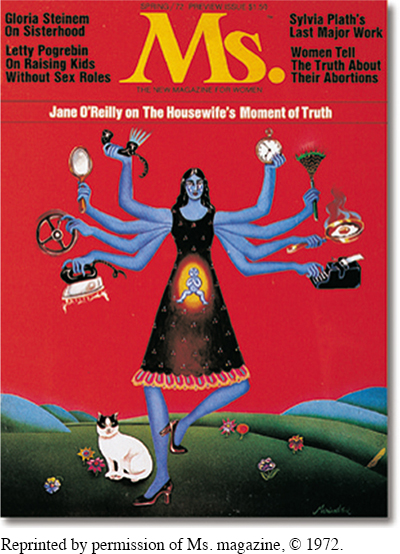The American Promise: Printed Page 823
The American Promise, Value Edition: Printed Page 744
The American Promise: A Concise History: Printed Page 850
A Multifaceted Movement Emerges
The American Promise: Printed Page 823
The American Promise, Value Edition: Printed Page 744
The American Promise: A Concise History: Printed Page 850
Page 823Beginning in the 1940s, large demographic changes laid the preconditions for a resurgence of feminism. As more and more women took jobs, the importance of their paid work to the economy and their families challenged traditional views of women and awakened many women workers, especially labor union women, to the inferior conditions of their employment. The democratization of higher education brought more women to college campuses, where their aspirations exceeded the confines of domesticity and of routine, subordinate jobs.
Policy initiatives in the early 1960s reflected both these larger transformations and the efforts of women’s rights activists. In 1961, Assistant Secretary of Labor Esther Peterson persuaded President Kennedy to create the President’s Commission on the Status of Women (PCSW). Its 1963 report documented widespread discrimination against women and recommended remedies, although it did not challenge women’s domestic roles. One of the commission’s concerns was addressed even before its report came out, when Congress passed the Equal Pay Act of 1963, making it illegal to pay women less than men for the same work.
Like other movements, the rise of feminism owed much to the black freedom struggle. Women gained protection from employment discrimination through Title VII of the Civil Rights Act of 1964 and the extension of affirmative action to women by piggybacking onto civil rights measures. They soon grew impatient when the government failed to take these new policies seriously. Determining the need for “an NAACP for women” to put pressure on the government and other institutions, Betty Friedan, civil rights activist Pauli Murray, several union women, and others founded the National Organization for Women (NOW) in 1966.
Simultaneously, a more radical feminism grew among mostly white young women active in the black freedom struggle and the New Left. Frustrated when male leaders dismissed and ridiculed their claims of sex discrimination, many women walked out of New Left organizations and created independent women’s liberation groups throughout the nation.
Women’s liberation began to gain public attention, especially when dozens of women picketed the Miss America beauty pageant in 1968, protesting against being forced “to compete for male approval [and] enslaved by ludicrous ‘beauty’ standards.” Women began to speak publicly about personal experiences that had always been shrouded in secrecy, such as rape and abortion. Throughout the country, women joined consciousness-
Radical feminists, who called their movement “women’s liberation,” differed from feminists in NOW and other more mainstream groups in several ways. NOW focused on equal treatment for women in the public sphere; women’s liberation emphasized ending women’s subordination in family and other personal relationships. Groups such as NOW wanted to integrate women into existing institutions; radical groups insisted that women’s liberation required a total transformation of economic, political, and social institutions. Differences between these two strands of feminism blurred in the 1970s, as NOW and other mainstream groups embraced many of the issues raised by radicals.
The American Promise: Printed Page 823
The American Promise, Value Edition: Printed Page 744
The American Promise: A Concise History: Printed Page 850
Page 824
Although NOW elected a black president, Aileen Hernandez, in 1970, the new feminism’s leadership and constituency were predominantly white and middle-
In addition to struggling with vast differences among women, feminism also contended with the media’s refusal to take women’s grievances seriously. For instance, when the House of Representatives passed an equal rights amendment to the U.S. Constitution in 1970, the New York Times criticized it in an editorial titled “The Henpecked House.” After Gloria Steinem founded Ms.: The New Magazine for Women in 1972, feminists had their own mass-
Ms. reported on a multifaceted movement that reflected the tremendously diverse experiences, backgrounds, and goals of American women. New women’s organizations represented ethnic and racial minorities, labor union women, religious women, welfare mothers, lesbians, and more. Other new groups focused on single issues such as health, education, abortion rights, and violence against women. In addition, U.S. women connected with women abroad, joining a movement that crossed national boundaries. (See “Beyond America’s Borders: Transnational Feminisms.”)
Common threads underlay the great diversity of organizations, issues, and activities. Feminism represented the belief that women were barred from, unequally treated in, or poorly served by the entire male-